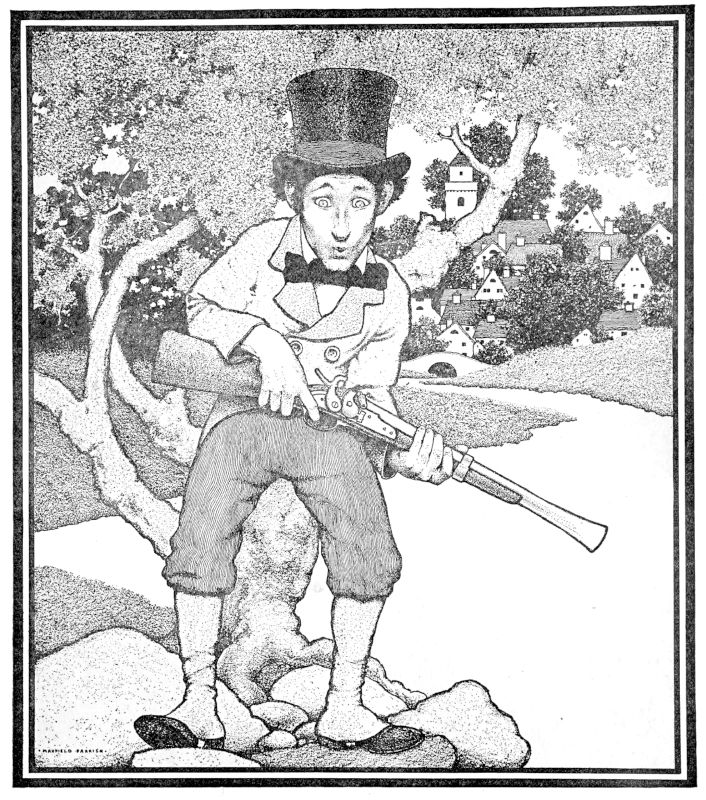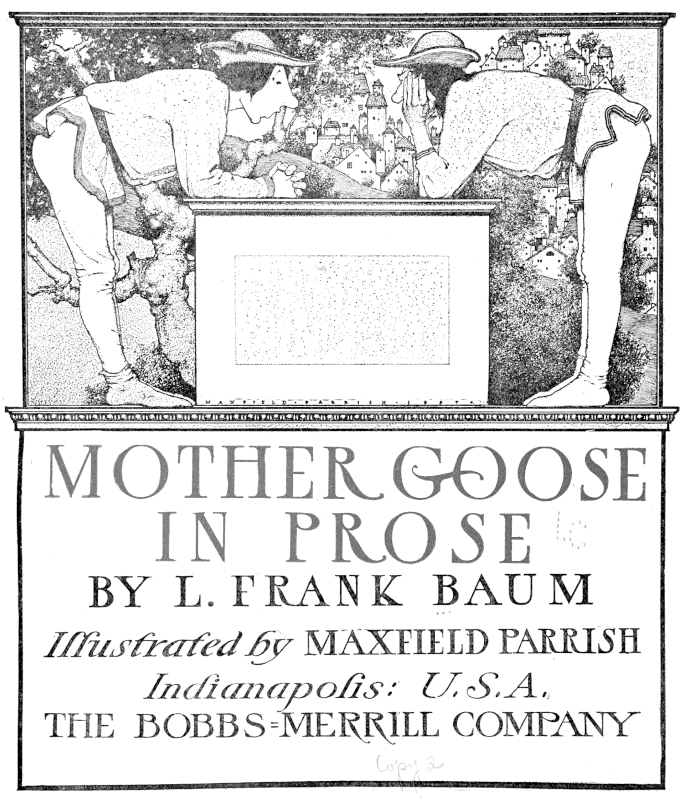 |
|
||
| Kellscraft
Studio Home Page |
Wallpaper
Images for your Computer |
Nekrassoff Informational Pages |
Web
Text-ures© Free Books on-line |
|
MOTHER GOOSE IN PROSE BY L. FRANK BAUM Illustrated by MAXFIED PARRIS   Indianapolis U.S.A. THE BOBBS MERRILL COMPANY 1905 Contents Sing a Song o' Sixpence The Story of Little Boy Blue The Cat and the Fiddle The Black Sheep Old King Cole Mistress Mary The Wond’rous Wise Man What Jack Horner Did The Man in the Moon The Jolly Miller The Little Man and His Little Gun Hickory, Dickory, Dock Little Bo-Peep The Story of Tommy Tucker Pussy-cat Mew How the Beggars Came to Town Tom, the Piper’s Son Humpty Dumpty The Woman Who Lived in a Shoe Little Miss Muffet Three Wise Men of Gotham Little Bun Rabbit The collection of jingles we know and love as the
“Melodies of Mother Goose” are evidently drawn from a variety of sources. While
they are, taken altogether, a happy union of rhyme, wit, pathos, satire and
sentiment, the research after the author of each individual verse would indeed
be hopeless. It would be folly to suppose them all the composition of
uneducated old nurses, for many of them contain much reflection, wit and
melody. It is said that Shelley wrote “Pussy-Cat Mew,” and Dean Swift “Little
Bo- Peep,” and these assertions are as difficult to disprove as to prove. Some
of the older verses, however, are doubtless offshoots from ancient Folk Lore
songs, and have descended to us through many centuries. The connection of
Mother Goose with the rhymes which bear her name is difficult to determine, and,
in fact, three countries claim her for their own: France, England and America. About the year 1650 there appeared in
circulation in London a small book, named “Rhymes of the Nursery; or Lulla-Byes
for Children,” which contained many of the identical pieces that have been
handed down to us; but the name of Mother Goose was evidently not then known.
In this edition were the rhymes of “Little Jack Horner,” “Old King Cole,” “Mistress
Mary,” “Sing a Song o’ Sixpence,” and “Little Boy Blue.” In 1697 Charles Perrault published in France a book
of children’s tales entitled “Contes de ma Mere Oye,” and this is really the
first time we find authentic record of the use of the name of Mother Goose,
although Perrault’s tales differ materially from those we now know under this
title. They comprised “The Sleeping Beauty,” “The Fairy,” “Little Red Riding- Hood,”
“Blue Beard,” “Puss in Boots,” “Riquet with the Tuft,” “Cinderella,” and
“Little Thumb;” eight stories in all. On the cover of the book was depicted an
old lady holding in her hand a distaff and surrounded by a group of children
listening eagerly. Mr. Andrew Lang has edited a beautiful English edition of
this work (Oxford, 1888). America bases her claim to Mother Goose upon the
following statement, made by the late John Fleet Eliot, a descendant of Thomas
Fleet, the printer: At the beginning of the eighteenth century there lived in
Boston a lady named Eliza Goose (written also Vergoose and Vertigoose) who
belonged to a wealthy family. Her eldest daughter, Elizabeth Goose (or
Vertigoose), was married by Rev. Cotton Mather in 1715 to an enterprising and
industrious printer named Thomas Fleet, and in due time gave birth to a son.
Like most mothers-in-law in our day, the importance of Mrs. Goose increased
with the appearance of her grandchild, and poor Mr. Fleet, half distracted with
her endless nursery ditties, finding all other means fail, tried what ridicule
could effect, and actually printed a book under the title “Songs of the
Nursery; or, Mother Goose’s Melodies for Children.” On the title page was the
picture of a goose with a very long neck and a mouth wide open, and below this,
“Printed by T. Fleet, at his Printing House in Pudding Lane, 1719. Price, two
coppers.” Mr. Wm. A. Wheeler, the editor of Hurd 8c Houghton’s
elaborate edition of Mother Goose, (1870), reiterated this assertion, and a
writer in the Boston Transcript of June 17, 1864, says: “Fleet’s book was
partly a reprint of an English collection of songs, (Barclay’s), and the new title
was doubtless a compliment by the printer to his mother-in-law Goose for her
contributions. She was the mother of sixteen children and a typical 'Old Woman
who lived in a Shoe.’ ”We may take it to be true that Fleet’s wife
was of the Vergoose family, and that the name was often contracted to Goose.
But the rest of the story is unsupported by any evidence whatever. In fact, all
that Mr. Eliot knew of it was the statement of the late Edward A.
Crowninshield, of Boston, that he had seen Fleet’s edition in the library of
the American Antiquarian Society. Repeated researches at Worcester having
failed to bring to light this supposed copy, and no record of it appearing on
any catalogue there, we may dismiss the entire story with the supposition that Mr.
Eliot misunderstood the remarks made to him. Indeed, as Mr. William H. Whitmore
points out in his clever monograph upon Mother Goose (Albany, 1889), it is very
doubtful whether in 1719 a Boston printer would have been allowed to publish
such “trivial” rhymes. “Boston children at that date,” says Mr. Whitmore, “were
fed upon Gospel food, and it seems extremely improbable that an edition could have
been sold.” Singularly enough, England’s claim to the
venerable old lady is of about the same date as Boston’s. Intro- There lived in
a town in Sussex, about the year 1704, Auction an old woman named Martha Gooch.
She was a capital nurse, and in great demand to care for newly-born babies;
therefore, through long years of service as nurse, she came to be called Mother
Gooch. This good woman had one peculiarity: she was accustomed to croon queer
rhymes and jingles over the cradles of her charges, and these rhymes “seemed so
senseless and silly to the people who overheard them” that they began to call
her “Mother Goose,” in derision, the term being derived from Queen Goosefoot,
the mother of Charlemagne. The old nurse paid no attention to her critics, but
continued to sing her rhymes as before; for, however much grown people might
laugh at her, the children seemed to enjoy them very much, and not one of them
was too peevish to be quieted and soothed by her verses. At one time Mistress
Gooch was nursing a child of Mr. Ronald Barclay, a physician residing in the
town, and he noticed the rhymes she sang and became interested in them. In time
he wrote them all down and made a book of them, which it is said was printed by
John Worthington & Son in the Strand, London, in 1712, under the name of
“Ye Melodious Rhymes of Mother Goofe.” But even this story of Martha Gooch is
based upon very meager and unsatisfactory evidence. The earliest English edition of Mother Goose’s Melodies
that is absolutely authentic was issued by John Newbury of London about the
year 1760, and the first authentic American edition was a reprint of Newbury’s
made by Isaiah Thomas of Worcester, Mass., in 1785. None of the earlier editions, however,
contained all the rhymes so well known at the present day, since every decade
has added its quota to the mass of jingles attributed to “Mother Goose.” Some
of the earlier verses have become entirely obsolete, and it is well they have,
for many were crude and silly and others' were coarse. It is simply a result of
the greater refinement of modern civilization that they have been relegated to
oblivion, while the real gems of the collection will doubtless live and grow in
popular favor for many ages. While I have taken some pains to record the
various claims to the origin of Mother Goose, it does not matter in the least
whether she was in reality a myth, or a living Eliza Goose, Martha Gooch or the
“Mere Oye” of Perrault. The songs that cluster around her name are what we
love, and each individual verse appeals more to the childish mind than does
Mother Goose herself. Many of these nursery rhymes are complete tales
in themselves, telling their story tersely but completely; there are others
which are but bare suggestions, leaving the imagination to weave in the details
of the story. Perhaps therein may lie part of their charm, but however that may
be I have thought the children might like the stories told at greater length, that
they may dwell the longer upon their favorite heroes and heroines. For that reason I have written this book. In
making the stories I have followed mainly the suggestions of the rhymes, and my
hope is that the little ones will like them, and not find that they interfere
with the fanciful creations of their own imaginations. L. FRANK BAUM. |